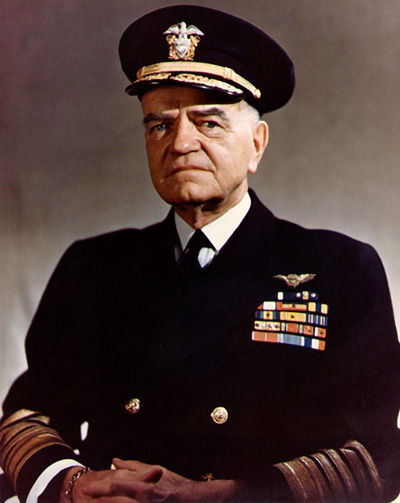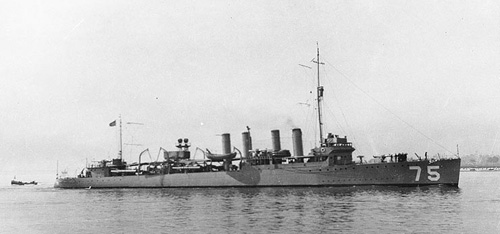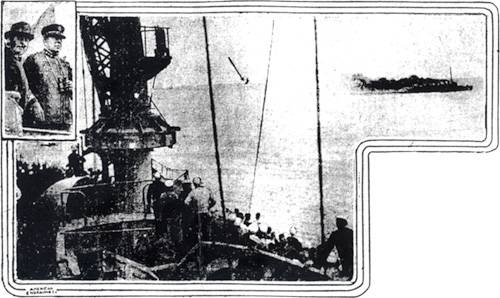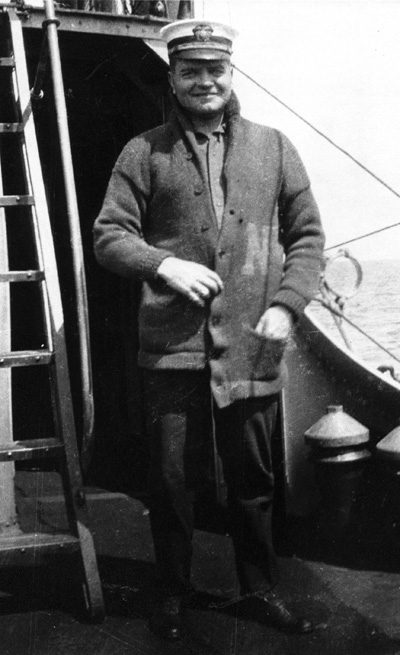
Fleet Admiral William F. "Bull" Halsey, 1945
The Bull
Halsey Connection
Long
before young Bill Halsey ever became a Fleet Admiral he was
a destroyer man and held the rank of Commander. In October,
1920 he assumed command of USS Wickes DD-75, the flagship
of Destroyer Division Ten based out of San Diego,
California. Wickes operated off the west coast into 1922,
conducting the usual target practices and exercises. One
such exercise was the ceremonious sinking of Ex-German
Submarine UB 88.
On the morning of January 2, 1921, Wickes stood out of San
Diego Harbor en route to San Pedro, Commander Halsey in
command. On the following day, Wickes stood out of San
Pedro and made preparations for firing on UB 88. After the
arrival of observation ship USS New Mexico, Wickes
commenced firing on the submarine. Twenty four-inch shells
were fired. At 4:16 in the afternoon UB 88 settled by the
bow and sank.
Halsey later stated in his memoirs that Wickes was "the
best ship I ever commanded; she was also the smartest and
the cleanest."

USS Wickes DD-75, circa 1920
USS
Wickes DD-75
Deck log
- January 3, 1921
At 2:01 sighted POCOMOKE with German Submarine U.B. 88 in
tow. At 2:05 started maneuvering at various speeds and
courses for position in order to commence firing on U.B.
88. At 3:14 sighted NEW MEXICO 3 points abaft port beam.
Maneuvering for position at end of watch.
Steaming as before on various courses at various speeds -
Stn'd speed 20 knots. At 4:00 Stn'd speed 15 knots. At 4:08
commenced firing on U.B. 88 with #1, 2, 4 guns. At 4:12
ceased firing and stopped. At 4:16 U.B. 88 sank, bow first.
At 4:20 standing in for San Pedro on various courses at
various speeds - Captain at the conn - Navigator on bridge.
Approved:
W.F. Halsey
Commander, U.S.N.
Commanding


Photograph
taken by George R. Watson, Times staff photographer, from
the forward turret of the New Mexico just as the former Hun
sea scourge, indicated by arrow, sank by the bow in her
last dive. At the extreme right is the destroyer Wickes,
which acted as executioner and which had already passed
it's target and the New Mexico as the U-boat sank, though
it began firing two miles to the left. In the inset are
Admiral Rodman and Fred L. Baker.
The
Execution on the High Seas Yesterday
of the Unterseeboot 88
Somewhere off San Pedro light at the bottom of the Pacific
lie the shattered remains of Unterseeboot 88, German terror
of the North Sea and which sank sixteen Allied vessels
during the last months of the World War. Stubbornly,
silently, the UB 88 nestled on the calm sea six miles out
from the Los Angeles Harbor yesterday afternoon until a few
of the best placed shots ever fired by American naval
gunners ripped it mercilessly from bow to stern, sending it
quickly into the depths of the sea and closing the last
chapter of one of the most frightful stories of terrorism
that ever invaded the worlds history.
The destroyer Wickes was the executioner of the condemned
submarine, and it's excellent gunnery was witnessed by
Admiral Rodman, his staff and a party of dignitaries aboard
the U.S.S. New Mexico, flagship of the Pacific Fleet and
observing ship during the sinking ceremonies.
The U-boat 88, towed by the Pocomoke, was sighted late in
the afternoon as it slipped through the enveloping fog.
Thirty-five hundred yards away, approximately two miles,
the Wickes awaited orders to commence firing. Suddenly
appeared a flash on the horizon and a four-inch shell
splashed a few yards astern of the U-boat 88.
The Wickes was steaming head on toward the U-boat 88 at
twenty knots an hour. A second shell came rattling through
space. Twelve seconds later a huge cloud of smoke arose
from the bow of the submarine. The wickes with it's second
shot had torn a gaping hole in the bow of the U-boat 88.
Came a tumultuous shout from the observers on the bridge of
the New Mexico.
Other shells, splashing on all sides of the submarine, sent
huge geysers of water into the air. One shot, with a
thunderous roar, crashed into the conning tower and
exploded. This shot, Admiral Rodman later stated, was one
of the most effective shots he ever witnessed. With the
demolition of the conning tower a submarine is rendered
completely useless. Shells struck it amidships, on deck and
in the stern and yet the stubborn hulk still tossed on the
surface of the sea.
The Wickes, steaming two-thirds speed ahead, began firing
broadsides at a range of one thousand yards and the UB 88
was engulfed in great clouds of smoke. Flames seen through
the shell holes told that it was afire inside, and yet it
refused to sink. Stored in one of the chambers were
twenty-five pounds of T.N.T., a powerful explosive which
was to be used to destroy the submarine if the shell fire
proved ineffective. But the cable that linked the submarine
with the Pocomoke had been severed by a shell and the
explosive could not be ignited.
Suddenly the UB 88 began to list. It tossed madly on the
water and began to settle by the bow. The stern heaved high
in the air and then, with the vessel two-thirds out of the
water, pointed straight to the skies, the diver paused for
a moment, then sank quickly. The second shot fired by the
Wickes had sunk the UB 88. The other hits had only speeded
up its last and fatal plunge.
Twenty four-inch shells were fired by the Wickes, and when
they had ceased firing Admiral Rodman ran up the signal,
"Well done." Aboard the New Mexico, as the UB 88
disappeared, Mayor Snyder, Harry Haldeman, Fred L. Baker,
Maynard McFie and a score of other prominent citizens,
guests of Admiral Rodman, threw their hats in the air and
mingled their cheers with the cheers of the crew.
"I'm glad that German thing is done for," said the Mayor.
The sinking of the UB 88 was less expensive than the
scrapping of it by the government would have been,
according to Admiral Rodman.
"Besides," he added, "It is a great moral lesson to those
who think they can terrorize the world with frightful
slaughter. The UB 88 received the same death penalty that
it had so ruthlessly passed upon many Allied vessels. Yet
the death of the UB 88 was more human. There was nobody
aboard it, while sinking of the sixteen Allied vessels by
the submarine caused the deaths of many innocent ones."
The UB 88 was one of five German submarines surrendered to
the United States by Germany after the armistice all of
which are destined to be sunk by American gunners. She was
one of the most modern submarines ever constructed, being
185 feet long, with a twenty-two foot beam, weighing 800
tons and equiped with powerful Diesel engines.

Cmdr. William F. Halsey aboard USS Shaw, August, 1918.
Photo by Lt. F.E. Sellman.
Snapshot
of Admiral Halsey By Fellow Officer
Sellman
The Scarsdale Enquirer - 1943
"The best officer I ever knew," wrote F.E. Sellman, of
Ferncliff Road, twenty-five years ago, under a picture he
had snapped of his immedite superior, Commander (now
Admiral) William F. Halsey, as they were going into
Heligoland Bight at the end of World War I, on the
destroyer, USS Shaw.
"After the passing of a quarter of a century, I still think
the same," said Mr. Sellman at his home this week.
The Shaw was the first American warship into Germany after
the Armistice and carried members of an inter-allied
commission to inspect German seaplanes and Zeppelins. Mr.
Sellman, then a Lieutenant in the Navy, served as
Engineering Officer with Commander Halsey, and sums him up
as being strict, fair and popular, a combination that
explains the absence of any qualifications in the line
written under the camera snap.
The picture shown above is another camera snap of the
distinguished Admiral of the Pacific when he was commanding
officer of the Shaw in the first World War. It was taken as
Commander Halsey was preparing to ascend the bridge at
Queenstown, Ireland, in August, 1918, preparing to get
underway. The sweater, buttoned askew, was a relic of the
Commander's football days at Annapolis. It was familiar
garment to the Shaw officers, who sometimes commented that
it was on its "last legs," but it was still treasured.
"If you take a look at Captain Halsey's chin of that day,"
said Mr. Sellman, "you'll notice it is exactly the same
chin you'll see in pictures of him today."
Mr. Sellman served with the Admiral on the USS Yarnell, as
well as the Shaw, and cruised with him from Danzig to the
coast of Mexico. Eating with him in the ward room for about
twelve months, he had a chance to get a good idea of the
Admiral's character leadership, and what has happened in
the Pacific hasn't surprised him any.
"He used to say that an officer was not a good destroyer
man until he had the most minute control of his ship. When
the destroyers moved in column he used to insist on running
close enough to the next ship to spit on the deck, and he
would really send a man to the fo'castle witha potato to
throw on the deck of the next ship. He was a good
disciplinarian, and in every respect a great
officer."
